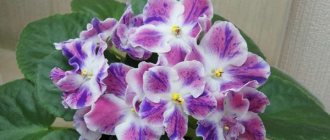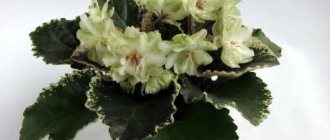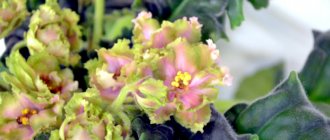When creating their own collection of Uzambara violets, it is advisable for beginning flower growers to first of all turn their attention to the varieties of exotic beauties obtained by domestic breeders.
The advantage of these varieties over foreign ones
is :
- Their complete adaptation to the microclimate;
- And the specifics of our homes.
The modes of all phases of the life activity of domestic violets fully comply with generally accepted criteria, and their decorative appearance is different:
- Effectiveness;
- Unsurpassed;
- And a variety of silhouettes.
From the incredibly extensive collection of Russian varieties, one can undoubtedly highlight the amazing violet “RM-New Year’s Tale” with:
- Carnival brightness of shades;
- And fancy accents in the colors of flowers.
Violet Summer Night (K. Morev)
The author of the delicate, airy Saintpaulia is Konstantin Morev, a breeder from Moscow. The name of the variety, produced in 2007, was inspired by the light purple color of the buds, reminiscent of a warm summer night.
Let's take a closer look at the violet:
- Summer night - Uzambara violet of the Gesneriev family ;
- genus – Saintpaulia hybrid ;
- flowers - light, voluminous double and semi-double stars 5-6 cm in size, color - soft purple, white in the center. The petals are framed with a white border. Blooms profusely;
- leaves are bright, rich green, slightly wavy. The rosette is neat, large, slightly loose. It harmoniously combines with strong peduncles and voluminous, light flowers. The root system is well developed.
violet Summer night.
Light blue prints appear if the room was cool when the buds were planted. The flowers themselves will be lighter, in some cases almost white.
Important! In rare cases, the Summer Night violet forms sports.
Violet Svetlana: description of the variety and characteristics
Violet Svetlana: photo of the variety
It is not so often possible to find this plant on the Internet, since not all flower growers know this species. The discoverer of this type of violet is florist Elena Lebetskaya.
When characterizing plants, it is worth focusing on the leaves, which play an important role in the decorative appearance of the plant. The foliage is emerald in color with the addition of pinkish and snow-white leaves. The stems are tall. Ribbed edges on leaves. The rosette is neat.
The inflorescence of the violet variety LE Svetlana is large, the size reaches up to seven centimeters, and can be with fibers or smooth. They have a light purple color, the petals are fragile and wavy. You may notice a slight blur of white.
The plant has snow-white buds edged with purple. Emerald foliage with yellow edging.
Caring for a plant at home
Saintpaulias grow at home without problems if you provide them with the following favorable conditions and proper care.
Irrigation regime
Proper watering is very important for violets. The Summer Night variety does not tolerate overwatering . If there is excess moisture and it gets on the leaves (especially the center of the rosette), the plant may rot.
If the soil is dry, the leaves turn yellow, growth slows down, and the flowers become smaller . The need for watering is determined by the condition of the soil. It should dry about 1 cm.
The water is preliminarily settled for a day. During this time it warms up to room temperature. When watering with cold water, brown spots appear on the leaves.
Water with a watering can with a long spout so that a stream of water can hit the soil without touching the leaves.
You can feed the plant with moisture through a tray . In this case, make sure that the water in the pan does not stagnate and is always fresh.
Another method of watering is wick. The wick is made from cloth. It is inserted into the drainage holes of the pot, and the other end is lowered into a container of water. The pot is placed on the container so that it does not touch the liquid. The fabric wick absorbs water, moistens the soil and provides moisture to the plant.
During active growth, development and flowering, violets are fed. Use any compositions for flowering indoor plants that are sold in the store. To avoid oversaturation with drugs, they are diluted with water until the concentration is halved.
All fertilizers must be diluted more than what is written in the instructions.
Feeding is carried out no more than once every 10 days . To ensure that the leaves are not too large and compact, nitrogen fertilizers are limited .
Lighting
Saintpaulia Summer Night prefers diffused, natural light. Daylight hours should be 11-13 hours . Therefore, in winter, when there is not enough sunlight, fluorescent lamps are used.
During hot weather, cover the windows with film or paper, preventing direct sunlight from falling on the flowers. This will protect the leaves from getting burned. If the light is too bright, the petals fade to a warm lilac color.
Air temperature
The optimal temperature for good development of Saintpaulia is 20-24 ° C. In winter it can drop to 18 °C.
Attention! At lower temperatures there is more white color on the petals. In the heat, the plant slows down all life processes, as if it freezes. Ice bottles placed between flower pots will help you survive the heat.
Remember, violet is afraid of drafts.
Humidity
For good development of Saintpaulia, air humidity should be in the range of 50-55% :
- with high humidity, the plant may rot;
- if it is low, growth and development will slow down significantly.
It is possible to increase humidity by placing open containers of water. It is good to use humidifiers.
Priming
The soil for growing Saintpaulia at home is chosen to be light, breathable, with a sufficient amount of minerals (potassium, phosphorus), with a moderate amount of nitrogen, with a pH of 5.5-6.5. Forest soil with the addition of biohumus, peat and vermiculite is well suited.
Hygiene
To make the plant look more impressive and neat, hygiene is carried out regularly. It involves removing yellowed, wilted, lower leaves, dried flowers and peduncles. If the stem of the plant is too bare, then it is sprinkled with earth.
The leaves can be periodically washed to remove dust . The soil is covered with a film, the flower is tilted and the dirt is washed off with a shower. It should be remembered that after this procedure the violet must be dried thoroughly and only then placed on the windowsill. Spots may appear on wet leaves from the sun.
Reproduction
The Summer Night variety is easy to propagate. You can use leaf cuttings, stepsons, peduncles.
Summer Night is easy to propagate.
Transplantation and rejuvenation
Saintpaulias are replanted 1-2 times a year. The best time for this procedure is spring. It is necessary to completely change the soil only if the violet has not been replanted for 2 or more years:
- Before replanting the plant, moisten the soil to make it easier to remove it from the pot and not damage the roots;
- The pot is turned over and the violet is transferred to a new container on a layer of drainage and soil;
- Align the plant in the center, fill the voids with fresh soil.
Those Saintpaulias that have a long stem . It is cut off, leaving 1 cm along with 5-6 leaves. They put it in water, wait for the roots to appear, then transplant it into the ground. After 2-3 weeks the plant will take root completely. During the rooting period, it is covered with film.
An old violet with a long stem can be rejuvenated.
Story
Svetlana has been growing violets since 1999; her collection includes more than 800 varieties and hybrids. And since 2001, Svetlana began independently breeding new varieties. This is how her first new releases, “The Favorite” and “Transparent Stream,” appeared.
Every year there were more and more new varieties and they reliably took their place in the hearts and collections of flower growers. More than 200 varieties created by Svetlana Repkina have been bred, and 20 of them are registered with AVSA, an international association that issues copyright certificates for new Saintpaulia varieties.
Attention : The most popular varieties of Svetlana Repkina's selection include: RS-Viscount, RS-Duchess, RS-Secret Sign, RS-Firebird, RS-Goldfish, RS-Mavka, RS-Margaret, RS-Golden Dragon, RS-Othello .
Most varieties of this breeder are distinguished by large flowers and good adaptability to environmental conditions (lighting, humidity, temperature).
Features of flowering, growth and reproduction
Violet Summer Night develops well at home and can adapt to environmental conditions. You do not need to have specific growing knowledge. It is enough to know the following features of flowering, growth and reproduction of Saintpaulia:
- it reproduces well by leaves and produces many children. The main thing is to choose the right leaf for planting. It must be absolutely healthy, without spots, damage, brightly colored, and of correct shape. It is cut with a blade at an angle of 45°. Pour settled water into a disposable glass, dissolve an activated carbon tablet in it, and place the leaf handle in the liquid. Leave until roots about 1 cm long grow. Then they are transplanted into prepared soil, covered with film until completely rooted;
Leaf propagation.
- on average, after 5-6 weeks a baby is formed. After 6-8 months she turns into a strong starter. After 12 months it becomes an adult plant, ready for its first flowering;
- Summer Night conveys varietal characteristics well . Sometimes sports can form. They manifest themselves in changing shades of colors;
- peduncles are strong . Flowering of Saintpaulia Summer night is abundant and caplike. In one bouquet, buds can have different shades. Young ones are brighter in color. During the long flowering process, the color becomes lighter. Flowers last up to two months;
- blooms irregularly . Each bloom can appear in different shades of purple - from light to darker;
- in hot weather the petals become brighter, in cool weather they become lighter;
- At low temperatures, the flower stalks become longer.
Reviews
Flower growers and connoisseurs of violets respect the Summer Night variety by Konstantin Morev, noting the plant’s unpretentiousness in care and the diversity in the shades of the petals.
Sergey. “The variety is gorgeous. The violet bloomed for the first time on the shelf. Therefore, the petals turned out to be very dark. This did not spoil the appearance; on the contrary, it added zest to it. It turned out to be an interesting option.”
Tatiana. “This is one of my favorite varieties for a long time and I think forever. Not greedy for flowers, bright, so different depending on temperature and lighting. It just warms the soul!”
Alice. “I love this violet! So neat, not capricious, blooming for a long time, sometimes bright, sometimes lighter. It pleases the eye with its rosette and lush bouquet. What else does an amateur gardener need to be happy!”
Energy of color
The popularization of violets has been in full swing lately. Thanks to the efforts of breeders, more and more people are decorating their homes with Saintpaulia . Beginning collectors are often afraid of failure when purchasing a particular variety.
The lilac violets described in the article are suitable for both beginners and experienced gardeners. What attracts these plants and why are they so popular?
The color range of lilac shades is large . There are not many of them in nature. Therefore, violets bred by creative and extraordinary people help bring harmony to the space of the house. It's warmer and more comfortable with them.
From all the variety of shapes - pansies, stars, bells, bowls, wasps - you can choose the one that suits you.
Terry, semi-double, simple, in the form of carnations or scalloped, with a border, fringe - they are equally beautiful and unique.
Lilac violets are fascinating, they have a mysterious energy that makes you kinder and calms you down. Chimeras and Saintpaulias with prints leave no one indifferent.
Important! It turns out that anyone can find a lilac Saintpaulia to their liking or create their own unique collection.











